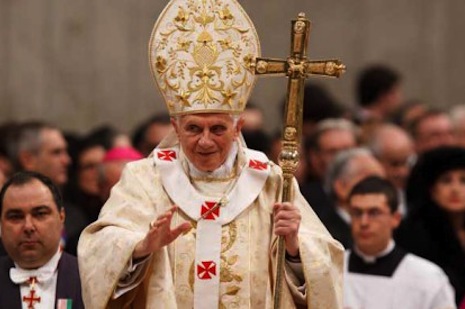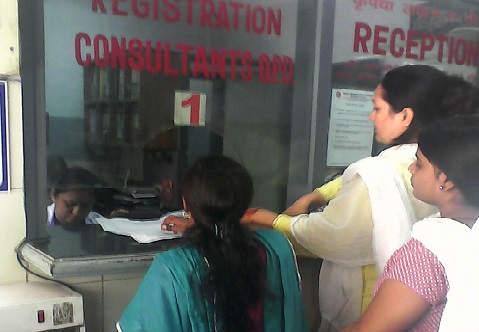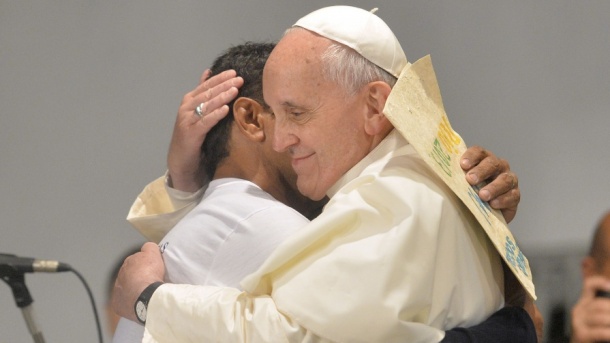Benedict XVI: ‘God told me’ to resign

Pope Emeritus Benedict XVI resigned from the papacy because “God told me” to, according to a report by a Catholic news agency.
The Zenit news agency reported on Monday (Aug. 19) that Benedict decided to step back as a result of what he described as a “mystical experience” that shouldn’t be confused with a vision.
That experience sparked an “absolute desire” to dedicate his life exclusively to prayer, in a solitary relationship with God, Benedict reportedly said.
Zenit writes that its report is based on the account of one of the few people who are granted a meeting with the former pope, who is living in a retrofitted monastery on the Vatican grounds.
Benedict shocked the world with the announcement of his resignation on Feb. 11, becoming the first pope to leave his job in more than 600 years. He told aides he intended to live out his life “hidden from the world.”
When he announced his resignation, Benedict told a group of cardinals in Latin that his “strengths” were no longer sufficient “to adequately fulfill the ministry entrusted to me” because of old age.
According to the report, Benedict also praised the “charisma” of his successor, Pope Francis, saying that his actions as the leader of the Catholic Church show that his election was “God’s will.”
Full Story: Benedict XVI: ‘God told me’ to resign
Source: Religion News Service
Public healthcare that fails to care

Malaria-stricken Rukhiya Malik, 27, sits in the corner of a medical facility run by volunteers in a Mumbai suburb. She is hoping for subsidized medicine for an energy-sapping disease that has left her too weak to walk or hold a long conversation.
“I can’t go to big hospitals,” she says. “I borrowed money from someone else to come here. Government hospitals are expensive. They charge for blood tests. Where would I get the money from?”
Having lost her father last year and her brother a few months later in a train accident, Malik is the family’s only breadwinner and has an aging mother to look after.
There are thousands like her, in Mumbai, who struggle to cope with the financial burden that illness brings with it. With 20 percent of Mumbai’s population – 3.5 million – living below the poverty line, good medical treatment is a luxury few poor can afford.
instead of the 70 government-run hospitals in India’s financial capital, they can only turn to clinics run by Trusts, which offer medicines at subsidized rates.
“The problem is that the population has increased and the authorities are not able to increase the number of health centers at this rate,” says Ravikanth Singh, who runs one such clinic. Hospitals “are in a pathetic condition” as they lack proper staffing and management.
Singh began his Doctors for You organization with some students from a government medical college in 2007. Within three years, he had launched a medical center in a slum area to provide general check-ups, immunization, dental care and primary health needs of the local community.
Mumbai has several facilities like Singh’s but not enough to bring solace to the thousands of poor, who live in crowded slums and eat and drink in highly unhygienic circumstances.
A report on the “State of Health in Mumbai,” published in July by an NGO, said city authorities must focus more on primary healthcare and ensure it caters to fulfilling the needs of the poor.
Public health surveillance needs to be immediately augmented, the report said.
Shaikh Naranum, 21, battling the first stages of tuberculosis, says she would choose an NGO-run clinic over a government facility for reasons that are not just financial.
Privately run multi-specialty hospitals “are the best but I don’t have money to afford them. I prefer hospitals run by trusts and NGOs … as they treat patients with respect.”
In Mumbai, it is always a case of survival of the fittest, says doctor Chirag Rathod, member of the Hope for the Hopeless team that organizes day-long free medical camps.
“If a person doesn’t have money, the only option they have is a government hospital and because of corruption in the system, patients here are taken for granted,” he says.
The authorities are making efforts to improve matters. In July 2012, the state government launched the Rajeev Gandhi Jeevandayee Yojana project, which provides health insurance coverage of up to 150,000 rupees for families whose annual income is less than 100,000 rupees a year.
The government also claims it has sanctioned up to 1.830 billion rupees (US$3 million) for hospitals to conduct up to 952 medical procedures for patients in the past year.
But government also says some 28 private and charitable hospitals in the city refuse to be part of this pro-poor scheme. Health Minister Suresh Shetty says the refusals are because the government’s fixed rates for treatment are too low.
While such disputes continue, the poor hit by malaria and tuberculosis – and with no possible access to expensive private treatment – have no choice but to deal with apathetic government hospitals or Trust-run clinics.
Wisdom Story – 67

by Paul Brian Campbell,SJ
“You have hardened,” said the flower, bending her petals downward toward the half stone at her roots. “These rains should have softened you, made you more fertile and receptive to the seeds of the fields; but no. You have accumulated minerals and have become more silent and full of calcium. Why do you stay here? Why do you resist the brook that gives us water?”
The stone said nothing.
A number of clouds passed by, the sun set and the night arrived with an immense bronze-colored freckled moon with acne scars upon her worn face and in this manner reflected down upon the silent stone which still had not fallen asleep. The flower, by now, had tucked-in her petals and slept profoundly, and at this time the stone began to answer:
“I stay here because your roots have made me yours. I stay here because it is no longer about my feeling the earth rather because I have become part of that which functions as a support of your stem which resists the wind and the rain. Everything changes, my sweet flower,” said the stone, “but I stay here because love is that microscopic space between your feet and my salted skin. You would only be able to feel it if destiny were ever to separate the two of us.”
The moon followed the fade of the stars. Dawn gave a yawn as the sun began to burn its horizon on the lower lip of the mouth of a new day. The flower awoke and extended her beautiful petals. “Good morning,” she said, “I dreamed that you were singing to me. How foolish of me, don’t you think?”
The stone said nothing.
Wisdom Story – 66

by Paul Brian Campbell,SJ
A young student at a Zen monastery comes to his master and throws himself at his feet, sobbing. The teacher lifts him up gently, and asks him, “What is troubling you, my son?” “O master,” the student falters, “I am so discouraged. My meditation is a nightmare-my mind is always running after worldly thoughts, my legs ache, I’m constantly falling asleep… I cannot concentrate on anything for even a breath. I think that I am just not cut out for meditation.”
The master pats his head and comforts him “Do not worry, my child. This is only a stage. It will pass, it will pass.” The student heaves a big sigh, bows to his master, and goes back to the meditation hall.
A few days later, he comes running to his master, grinning from ear to ear. “O master, by your grace, my meditation is completely transformed now! I’m getting so much joy, so much peace, so much depth…” The master responds calmly, “Do not worry, my son. It will pass.”
Abu al-Abbas al-Mursi Mosque, Alexandria

The Abu al-Abbas al-Mursi Mosque is the most historic and most beautiful mosque in Alexandria. It was built primarily in 1775 over the tomb of a Spanish scholar and saint, Abu El Abbas El Mursi (1219-86), and stands on Mosque Square overlooking the eastern harbor.
History
Abu al-Abbas al-Mursi (whose full name is much longer) was born to a wealthy family in the Andalusia region of Spain in 1219. In the wake of increasing Christian control of Spain, he and his family left for Tunisia in 1242. He later went on to Alexandria, a popular destination of many Muslim scholars at the time.
Abu al-Abbas lived in Alexandria for 43 years as a scholar and teacher until his death in 1286. He was buried in a small building near the eastern harbor in Alexandria.
In 1307, El Sheikh Zein El Din Ibn El Qattan, one of the richest traders of Alexandria, visited the tomb. He funded a mausoleum and dome for the tomb, along with a small mosque. The tomb of Abu al-Abbas became a place of pilgrimage for many Muslims from Egypt and Morocco who passed through Alexandria on their way to and from Mecca.
The mosque was periodically restored over the centuries by rulers who built themselves tombs next to the saint. Most of the present structure dates from 1775, when the Algerian Sheikh Abu el Hassan El Maghreby built a much larger mosque on the site. It was fully renovated in 1863, and an annual festival was established to celebrate the birth of Abu al-Abbas al-Mursi.
The mosque was again beautified in 1943 under King Farouq I (r.1937-1952), who built the Midan el Masaged, or “Mosque Square.” The square covers some 43,200 square meters and includes five other mosques centered around the Abu al-Abbas al-Mursi Mosque. The mosque was renovated in the Arabian style that was popular when the saint came to Alexandria in the 13th century, at a total cost of about 140,000 LE.
What to See
The cream-colored Abu al-Abbas al-Mursi Mosque stands 23 m high and dressed in artificial stone, with a minaret on the southern side rising to 73 m. Situated near the shore of the eastern harbor, the mosque and its neighbors can be clearly seen from the sea. The minaret has an Ayoubids design, with four sections of different shapes. The mosque has an entrance on the north and one on the east, both of which overlook the square. The main part of the mosque is an octagon, with internal walls are dressed in artificial stone except for a 5.6 m-high mosaic.
The high ceiling is decorated with arabesque and contains a great octagonal skylight known as a Shokhsheikha. Each side of the skylight has three windows of colored glass in arabesque designs set into aluminum frames. This skylight is surrounded by four domes, placed over the four mausoleums within the complex.
The floors are paved in white marble. The doors, minbar and windows are made of joined and finely carved teak, citronia and walnut. The minbar (pulpit) is capped by a dome and has verses from the Qur’an written at the top in French gold. The mihrab (niche indicating the direction of Mecca) stands at the base of the mosque’s minaret and is flanked by the creed, “There is no god except Allah and Muhammad is the prophet of Allah” in Arabic script. Also on either side of the mihrab are two columns of Egyptian granite, with the name of Muhammad written in Kufic Arabic calligraphy at each end.
The mayda, an absolution area, along with the lavatories, are on the western side of the mosque with their own entrance overlooking the square. According to a royal order, the necessary alterations were made to reserve a special worship area for women with a private entrance.
An Authentic Commitment

Biblical Reflection for the Twentieth Sunday in Ordinary Time, Year C – August 18, 2013
The Scripture readings for the 20th Sunday in Ordinary Time invite us to consider the implications of our commitments, our lifestyles and our relationships with others. In the first reading from Jeremiah, the biblical prophet is called to comfort the afflicted and to afflict the comfortable. Jesus, like Jeremiah, will experience the prophet’s fate [Jeremiah 38:4-6,8-10].
In the second reading from the letter to the Hebrews [12:1-4], we learn once again that Jesus, the great architect of the Christian faith had himself to endure the cross before receiving the glory of his triumph. Reflection on his sufferings gives us courage to continue the struggle, if necessary even to the shedding of blood. We must regard our own sufferings as the affectionate correction of the Lord, who loves us as a father loves his children.
In Sunday’s Gospel [Luke 12:49-53] Jesus reminds the crowd that those who commit to him will find that it affects the way they relate to friends and family members. A serious commitment to Jesus forces us to change the way we live our lives, and this can put strains on relationships. We don’t expect to hear such difficult words from Jesus in the Gospels. But it is good to be reminded once in a while that the decision to do the right thing, the good thing and the best thing, is not always easy and without conflict. Jesus himself did not make easy decisions and avoid conflict. Jesus reminds his followers to be prepared for difficult decisions and conflict as well.
Jesus demands a decision either for or against his message
The baptism referred to in Sunday’s Gospel is actually Christ’s passion and death. He longs for this event to take place [Luke 12:50]. Family members are divided against one another; the harsh reality is that the Church’s mission of conversion will not be a total success. Jesus demands a decision either for or against his message. “I came to bring fire to the earth and how I wish it were already kindled” [Luke 12:49]. Jesus did not sit on the fence, resisting hard decisions for fear of not being accepted. He never sought harmony and a middle way in every dispute. He walked into the midst of great conflicts of his time and was unafraid of making tough decisions.
Let us reflect for a moment on our own lack of courage and conviction in the many decisions we must make in life. Many of us hold a view that Christians should always seek harmony and a ‘middle way’ in every dispute and we assume that tension and conflict are worse evils than injustice and oppression. We place a very high premium on being liked and accepted by everyone! And we are often very afraid of revealing who we really are and what we really believe to those we think are friends! We fear rejection!
Podcast : Digital Evangelization

James Martin, S.J., discusses his new e-book, Together on Retreat: Meeting Jesus in Prayer. Father Martin is a contributing editor at America and author of The Jesuit Guide to (Almost) Everything and Between Heaven and Mirth. You can find him on Twitter @jamesmartinsj or www.facebook.com/frjamesmartin.
|
|
| Download MP3 |
The Vigil: a spot on the beach

On the Saturday morning of the Vigil, my brother and I packed all our belongings and took the train to Central. With the 10km walk to Copacabana beach, there was an added two hour line-up for food and one hour line-up for washrooms. It was a total seven hours before getting to the beach. With a week of fighting crowds, eating little, and walking lots-this was just the final hurdle of our pilgrimage.
After receiving our food boxes-energy bars, crackers, juice, chips, and three cans of tuna-we returned to the road. Colourful crowds paraded through the laneways and cultural songs blended into the distinct monotone of the Rosary, which was drowned out by honking horns and sudden outbursts of, “We are the youth of the pope!”
Our small group arrived at the beach early enough to stake out a territory. We spread out a big blue tarp and worried about the large waves drenching our belongings. Others, more desperate than us, moved in even closer to the water. They hurriedly built barricades and ditches like others along the shoreline.
Quickly and organically, pilgrims devised a makeshift favela. We joked that we lived in the suburbs: small lanes appeared with neat borders along the claimed territories waving their flags. The unfortunate, that is, those nearest to the street, were quickly trampled by the continuous inflow of pilgrims trying to find even the smallest amount of space. pilgrims vigil
Though we were camped at the last TV screen from the stage, another kilometre or so of pilgrims densely packed in behind us. Others peopled the sidewalks, and still others slept on the streets.
Perhaps there hadn’t been enough time to transport all the port-a-potties from the original Campus Fidei (turned a mud pool from the rain and now hosting five crocodiles), but in the morning the washroom situation remained the most unpleasant detail of the weekend.
How impressive that so many still came and stayed despite poor conditions for both sleep and hygiene.
Albeit the drone of the helicopters and the crashing of the waves, there was ultimate silence as Pope Francis addressed the crowds. He preached dedication to prayer, the sacraments, and to helping others. He spoke of a “Revolution of Love.”
His example perhaps more than his words struck us most: a deep affection for all those who came to greet him, a simple poverty of spirit, a humble manner, an enthusiasm for the hope that Christ promises.
Earlier, my brother and I had considered how difficult it is to believe that anything could be done about the overwhelming problems of our society. We wondered whether it would be fair to bring up children in a world that seems destined only for further destruction and greater suffering.
I took in the crowds that Vigil evening as they kneeled and adored the Blessed Sacrament. And later, I heard the words of Pope Francis-build a better world.
Why not believe; I feel the responsibility of our hope.
—
This post was submitted by Jocelyn Kilpatrick, a pilgrim from the Toronto area.
(photo J.Kilpatrick)
Love the alien as yourself – This Catholic’s View
Octavio Gonzalez, a graduate of Georgetown University, would be picking corn and raising a few cattle in El Teul de Gonzalez, Mexico, if his father had not illegally trekked across the hills at the U.S.-Mexico border near San Ysidro, California, in 1969.

Mr. Gonzalez never planned to stay permanently in the U.S., but he wanted something better for his children after he married a woman who had also crossed into the U.S. illegally after being turned back by a border guard who refused to let her cross even though she had a valid visa.
“As much as they both wanted to stay with their families in Mexico, it was becoming clear to them that their aspirations for their children would not be possible living in Mexico,” Octavio explained to a forum sponsored by the Woodstock Theological Center at Georgetown University on Tuesday. “If they stayed to raise a family in Mexico, their children, like them, would go to school six months out of the year and work the fields on the ranch. We would certainly never get the opportunity to study through college.”
The forum was moderated by Jill Marie Gerschutz, who with Donald M. Kerwin, Jr., edited And You Welcomed Me: Migration and Catholic Social Teaching (Lexington Press, 2009).
The Gonzalez family story exemplifies that “A migrant is a person possessed by a dream, just like you and me,” as Bishop Gerald Kicanas, vice president of the National Conference of Catholic Bishops, told a Georgetown audience last month. “They’re trying to improve their lives, live their lives with some dignity, with some semblance of value and meaning.”
Speaking at the same forum as Octavio Gonzalez, Cardinal Theodore McCarrick explained why the Catholic Church supports comprehensive immigration reform that provides a path to citizenship. The church’s teaching on immigration is based on the fact that “We are all brothers and sisters in God’s one family,” he said. Or as Pope Benedict XVI said in his latest encyclical, Caritas in Veritate: “Every migrant is a human person who, as such, possesses fundamental, inalienable rights that must be respected by everyone and in every circumstance.”
The retired archbishop of Washington reminded the audience that the people of Israel were immigrants and God had told them in Leviticus (19:33-34): “When an alien resides with you in your land, you shall not oppress the alien. The alien who resides with you shall be to you as the citizen among you; you shall love the alien as yourself, for you were once aliens in the land of Egypt.”
With Christmas less than two months away, the cardinal recalled that Jesus and the Holy Family were also refugees in Egypt when they fled from Herod.
“Christ lived as a migrant and a refugee for a reason,” he asserted, “in order to live with his people in solidarity, to provide example to all generations, even to this day, and to give witness to the Kingdom of God.”
Jesus made this explicit in his teaching when he said that to attain the Kingdom of Heaven, we must welcome the stranger. “For I was hungry and you gave me food, I was thirsty and you gave me something to drink, I was a stranger and you welcomed me…. Just as you did this to the least of these who are members of my family, you did it to me.”
Like the late John Paul II, McCarrick saw in the parable of the Good Samaritan a message about immigration. He quoted John Paul, who said: “For her part, the church, like the good Samaritan, feels it her duty to be close to the illegal immigrant and refugee, contemporary icons of the despoiled traveler, beaten and abandoned on the side of the road to Jericho.”
Pope Benedict has continued this solidarity with immigrants by encouraging the U.S. bishops “to continue to welcome the immigrants who join your ranks today, to share their joys and hopes, to support them in their sorrow and trials, and to help them flourish in their new home.”
McCarrick decried “the broken immigration system and a toxic political atmosphere which has prevented humane reform of this system.” The Catholic community witnesses “families being separated, migrant workers being exploited, and families mourning the death of loved ones who die on their journey to the United States.”
“We must change our laws so as to bring the undocumented out of the shadows, provide safe passage to those who want to come to work or join their families in our country, and address the economic inequities which compel persons to leave their homes in search of employment,” he said.
Octavio’s parents did legalize their status in 1986 under the Immigration Reform and Control Act. His parents now could become active in their community and church and buy a home and car. Their five sons were already American citizens having been born here, so Octavio, a hard working student, had no problem going to college. He is now a legal assistant at the Immigrants’ Rights Clinic at Stanford Law School.
But Octavio told of another exceptional high school graduate, Jessica, whose dream of college is at risk. Although only three years old when brought across the border by her parents, she has no path to citizenship available and could be sent back to a country she does not even remember despite the fact that all of her teachers and peers consider her an exemplary person.
Perhaps the immigration debate says as much about us as a country as it does about the immigrants. Who do we want to be? As the Catholic bishops of Mexico and the United States stated in their joint pastoral letter, Strangers No Longer, “We judge ourselves as a community of faith by the way we treat the most vulnerable among us.”
Thomas J. Reese, S.J., is Senior Fellow at Woodstock Theological Center at Georgetown University.
Karnak Temple, Luxor

Karnak Temple is a vast temple complex in Luxor dedicated primarily to Amun and dating from as early as 2000 BC. It is an impressive sight, and second only to the Great Pyramids in popularity.
History
After a century of foreign occupation, the New Kingdom (1550-1150 BC) of Egypt emerged, with its capital at Thebes. The captial city was embellished with grandiose temples worthy of the majesty of the pharaohs, the greatest being Karnak.
The temple complex of Karnak, dedicated to the Pharoah Amun, was the center of his worship and of his wife Mut and their son Khons. Each of them had a “precinct” (area) in the temple complex, the greatest and largest belonging to Amun. There was also a precinct for Montu, the falcon-headed local god.
Construction on the Karnak temple complex began in the 16th century BC and continued into the Greco-Roman period – a period of up to 1300 years of construction. Around 30 successive pharoahs added their own touches to the complex: a new temple, shrine, or pylon and carved detailed hieroglyphic inscriptions.
When the pharoah Akhenaton abandoned the traditional worship of Amun and took up the worship of Aten, the sun god, he built a temple to Aten at Karnak. But after his death, the Theban priests destroyed all signs of sun worship at Karnak and elsewhere.
What to See
The Karnak temple complex is huge, covering a site almost a mile by two miles in area. There are over 25 temples and chapels in the complex, including separate shrines for the three boats that took the statues of the gods on their annual trip on the flooding Nile. Sanctuaries, obelisks, and groups of columns all feature accounts of the heroic deeds of the sponsoring pharoah.
The key difference between Karnak and most of the other temples and sites in Egypt is the length of time over which it was developed and used. Approximately 30 pharaohs contributed to the buildings, enabling it to reach a size, complexity and diversity not seen elsewhere. Few of the individual features of Karnak are unique, but the sheer size and number of features makes it one of the most impressive temple complexes in Egypt.
The Karnak complex includes several of the finest examples of ancient Egyptian design and architecture. Among them are the Hypostyle Hall, considered one of the world’s great architectural achievements. It is filled with 134 enormous pillars, the highest 70 feet tall, and each about 45 feet around. The hall covers an area of 64,586 sq ft.
The most spectacular of the temples at Karnak is the Temple of Amun (Amun’s Precinct), the only section open to the public. This is entered via the Avenue of the Sphinxes, or Sacred Way, that once stretched the two miles from Karnak to Luxor Temple.
The Obelisk of Thutmose I, a 22m (71ft) monument, is the only one of four original obelisks that is still standing.
Getting There
The vast majority of tourists visit Karnak Temple as part of an organised coach tour, but it is also possible to take a public minibus (25pt) from Luxor Bus Station, or hire a taxi or caleche (horse and cart) – both officially priced at £E10 – from the center of Luxor.





